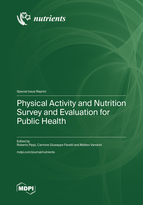Physical Activity and Nutrition Survey and Evaluation for Public Health
A special issue of Nutrients (ISSN 2072-6643). This special issue belongs to the section "Sports Nutrition".
Deadline for manuscript submissions: closed (15 March 2023) | Viewed by 29114
Special Issue Editors
Interests: childhood obesity; health promotion; lifestyle; Mediterranean diet; obesity and diabetes prevention; physical activity; quality of life; wellbeing
Interests: health promotion; nutrition; physical activity; diabetes; metabolic disorders
Interests: physical activity; exercise; obesity; diabetes; functional evaluation; motor competence
Special Issues, Collections and Topics in MDPI journals
Special Issue Information
Dear Colleagues,
Physical activity and nutrition are two of the most important modifiable lifestyle factors that affect health status, both in healthy people and in special populations with metabolic disorders and non-communicable diseases (e.g., obesity and type 2 diabetes (DM2)). Their assessment is mandatory to properly implement healthy lifestyle habits and modifications (i.e., suggest a nutritional medical therapy, prescribe exercise programs or simply improve state of health).
The aim of this Special Issue is to improve the knowledge regarding physical activity and human nutrition aspects, with an emphasis on (but not limited to) assessment and evaluation for public health, in healthy people, athletes and in both general and pathological populations, during the entire lifespan.
We are pleased to invite you to submit a contribution in the form of an original research article or narrative or systematic review. Research areas may include (but are not limited to) the following:
- Physical activity;
- Exercise testing and evaluation;
- Nutrition survey;
- Lifestyle assessment;
- Body composition evaluation;
- Health and non-communicable diseases.
We look forward to receiving your contributions.
Dr. Roberto Pippi
Dr. Carmine Giuseppe Fanelli
Dr. Matteo Vandoni
Guest Editors
Manuscript Submission Information
Manuscripts should be submitted online at www.mdpi.com by registering and logging in to this website. Once you are registered, click here to go to the submission form. Manuscripts can be submitted until the deadline. All submissions that pass pre-check are peer-reviewed. Accepted papers will be published continuously in the journal (as soon as accepted) and will be listed together on the special issue website. Research articles, review articles as well as short communications are invited. For planned papers, a title and short abstract (about 100 words) can be sent to the Editorial Office for announcement on this website.
Submitted manuscripts should not have been published previously, nor be under consideration for publication elsewhere (except conference proceedings papers). All manuscripts are thoroughly refereed through a single-blind peer-review process. A guide for authors and other relevant information for submission of manuscripts is available on the Instructions for Authors page. Nutrients is an international peer-reviewed open access semimonthly journal published by MDPI.
Please visit the Instructions for Authors page before submitting a manuscript. The Article Processing Charge (APC) for publication in this open access journal is 2900 CHF (Swiss Francs). Submitted papers should be well formatted and use good English. Authors may use MDPI's English editing service prior to publication or during author revisions.
Keywords
- physical activity
- exercise testing and evaluation
- nutrition survey
- evaluation
- lifestyle assessment
- body composition evaluation
- health and non-communicable diseases








